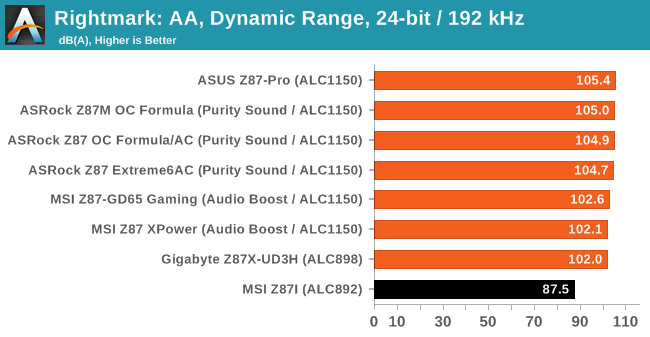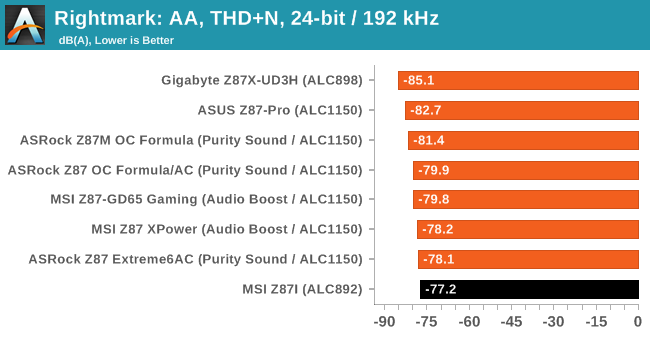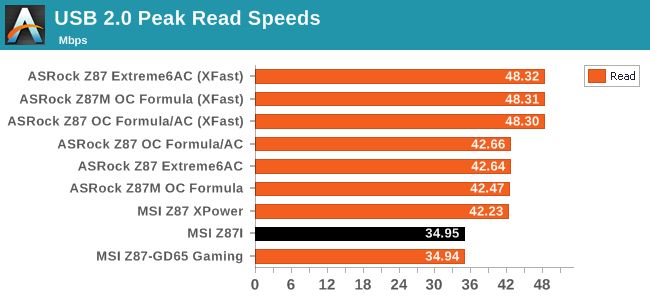MSI Z87I Review: Mini-ITX Haswell for $140
by Ian Cutress on August 27, 2013 10:15 AM EST- Posted in
- Motherboards
- MSI
- Mini ITX
- Z87
System Benchmarks
Rightmark Audio Analyzer 6.2.5
In part due to reader requests, we are pleased to include Rightmark Audio Analyzer results in our benchmark suite. The premise behind Rightmark:AA is to test the input and output of the audio system to determine noise levels, range, harmonic distortion, stereo crosstalk and so forth. Rightmark:AA should indicate how well the sound system is built and isolated from electrical interference (either internally or externally). For this test we connect the Line Out to the Line In using a short six inch 3.5mm to 3.5mm high-quality jack, turn the OS speaker volume to 100%, and run the Rightmark default test suite at 192 kHz, 24-bit. The OS is tuned to 192 kHz/24-bit input and output, and the Line-In volume is adjusted until we have the best RMAA value in the mini-pretest. We look specifically at the Dynamic Range of the audio codec used on board, as well as the Total Harmonic Distortion + Noise.


In terms of dynamic range, the ALC892 leaves a lot to be desired compared to the ALC898 and ALC1150.
USB Backup
For this benchmark, we run CrystalDiskMark to determine the ideal sequential read and write speeds for the USB port using our 240 GB OCZ Vertex3 SSD with a SATA 6 Gbps to USB 3.0 converter. Then we transfer a set size of files from the SSD to the USB drive using DiskBench, which monitors the time taken to transfer. The files transferred are a 1.52 GB set of 2867 files across 320 folders – 95% of these files are small typical website files, and the rest (90% of the size) are the videos used in the WinRAR test. In an update to pre-Z87 testing, we also run MaxCPU to load up one of the threads during the test which improves general performance up to 15% by causing all the internal pathways to run at full speed.


Nothing particularly special about USB speeds, in line with other Z87 MSI motherboards tested in the past.
DPC Latency
Deferred Procedure Call latency is a way in which Windows handles interrupt servicing. In order to wait for a processor to acknowledge the request, the system will queue all interrupt requests by priority. Critical interrupts will be handled as soon as possible, whereas lesser priority requests, such as audio, will be further down the line. So if the audio device requires data, it will have to wait until the request is processed before the buffer is filled. If the device drivers of higher priority components in a system are poorly implemented, this can cause delays in request scheduling and process time, resulting in an empty audio buffer – this leads to characteristic audible pauses, pops and clicks. Having a bigger buffer and correctly implemented system drivers obviously helps in this regard. The DPC latency checker measures how much time is processing DPCs from driver invocation – the lower the value will result in better audio transfer at smaller buffer sizes. Results are measured in microseconds and taken as the peak latency while cycling through a series of short HD videos - under 500 microseconds usually gets the green light, but the lower the better.

Peak DPC latency for Z87 platforms continues to poll over 145 microseconds, suggesting that is still a generational issue. If you want lower, then something other than Z87 might suffice.










46 Comments
View All Comments
Meaker10 - Wednesday, August 28, 2013 - link
No they are not, while the devices will plug into both slots, a mSATA drive will not work in a mini PCI-E slot and a mini PCI-E card will not work in an mSATA slot meaning they are physically compatible but not electrically compatible.There are a few SSDs that have a SATA to PCI express bridge and these will only work in mini pci express slots and wont be bootable.
Jason33 - Wednesday, August 28, 2013 - link
mSATA and mPCIe are electrically compatible. You only need to mux the data signals on the motherboard to either go to the SATA controller or the PCIe controller.Using this mux chip on the motherboard would work: http://www.nxp.com/documents/application_note/AN11...
Meaker10 - Thursday, August 29, 2013 - link
Yes they are compatible with a MUX, so how is that going to help with an mSATA/PCI-E slot that is not muxed?I have yet to see a consumer device with that muxed in so it's a pointless argument to make.
Jason33 - Thursday, August 29, 2013 - link
Several ThinkPads and notebooks for a few years now have done this. I'm running an mSATA drive in my ThinkPad that used to have a mPCIe WWAN card. There are also mini motherboards that can accept either type of card.Jason33 - Friday, August 30, 2013 - link
Also, I do agree that slots that don't have a mux will only allow one type of card. However, most consumer boards, notebooks and pre-built systems I've personally encountered that support mSATA cards also support mPCIe cards for the same slot.To answer kwrzesien's original question, MSI doesn't advertise it as supporting mSATA. If it did, they'd definitely say so. No reason to not advertise a feature. If you really want a Z87 ITX board with an mSATA slot then the ASRock Z87E-ITX has a full height mSATA/mPCIe slot in addition to the half height mPCIe slot holding the 802.11ac WiFi module.
1Angelreloaded - Thursday, August 29, 2013 - link
You are right and wrong, MSATA was initially made to use as a caching flash for Laptop hardrives, an MSATA port is different from MPCIe look at the combo card Asus gives in its ROG series Mobos, trust me they are incompatible.1Angelreloaded - Thursday, August 29, 2013 - link
No different channel slot type , do yourself the favor pay 50$ more and get the Asus Maximus Impact, much better.DanNeely - Tuesday, August 27, 2013 - link
Something's not consistent here:6 x USB 3.0 (Chipset) [4 back panel, 1 header]
4 x USB 2.0 (Chipset) [2 back panel, 2 header]
Assuming the totals are correct you're counting USB3 headers on one line, and USB2 ports from headers on the second.
IanCutress - Tuesday, August 27, 2013 - link
Ah yes, I normally have a header equal to two ports unless otherwise stated. Table is fixed.Ian
The Von Matrices - Tuesday, August 27, 2013 - link
Unfortunately a few of the motherboard articles posted in the past few weeks are incorrect regarding the Flex IO configuration. In this article, it states "This amount of extra network controllers is due to the Flex IO allocation – as the board only has four SATA 6 Gbps and six USB 3.0 from the chipset, this gives the other 8 Flex IO lanes all the PCIe 2.0 for these controllers." However, the Flex I/O allocation in the specifications table states that there are 6/4/8 SATA/USB 3/PCIe 2.Similarly, the review of the ASRock Z87 Extreme6/AC is incorrect in this regard as well. It states that "Out of our total 18 PCH Flex IO ports on board, this means we have six for SATA 6 Gbps ports, we also have four for USB 3.0 (PCH are headers, ASMedia on Rear IO) leaving eight for PCIe 2.0 lanes." I own a Z87 Extreme6, and I can tell you that this is not correct. The Flex I/O allocation in this board is 6/6/6 SATA/USB 3/PCIe 2. The rear USB 3.0 ports are driven by an ASMedia ASM1074 USB hub, not an ASMedia PCIe USB 3 controller, as would be implied by the Flex IO table in the article.